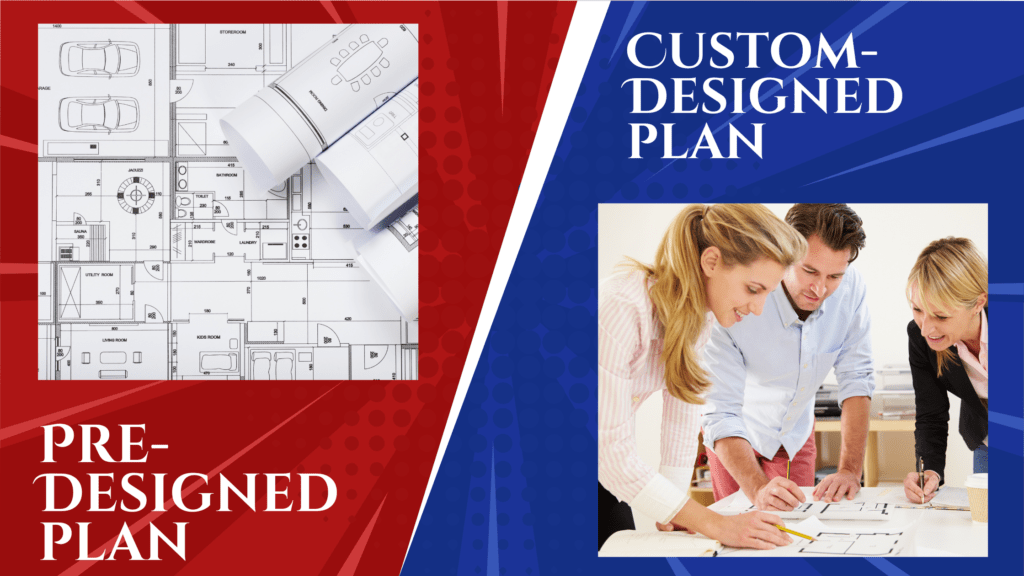Table of Contents
Introduction
Building a home is a significant investment, and choosing the right approach—whether a custom home design or a pre-designed plan—can greatly impact your experience. Your decision will depend on your budget, timeline, site conditions, and personal preferences. At Unified Studio Architect, we assist clients in selecting the best option based on their unique needs, ensuring a smooth and efficient home design process.
1. Understanding Custom Home Design

What Is a Custom Home?
A custom home is designed from scratch to meet the homeowner’s specific needs, preferences, and lifestyle. Unlike pre-designed plans, a custom home allows for complete control over every aspect of the design, from layout and materials to unique architectural elements.
Benefits of Custom-Designed Homes
- Personalization: Every detail is tailored to your vision, from room sizes to finishes.
- Unique Layouts: You’re not limited by standard floor plans, ensuring a home that fits your lifestyle.
- Site-Specific Planning: Architects optimize the design for your land’s specific features, such as topography, climate, and orientation.
The Process of Working with an Architect
- Consultation: Discuss your vision, budget, and expectations.
- Concept Development: The architect creates initial sketches and layouts.
- Design Refinement: Revisions are made based on your feedback.
- Construction Documents: Detailed plans and specifications are finalized.
- Permits & Approvals: The design is submitted for regulatory approvals.
- Construction Coordination: The architect may oversee construction to ensure design integrity.
2. Understanding Pre-Designed House Plans
What Are Pre-Designed House Plans?
Pre-designed house plans are ready-made blueprints created by architects and designers. They provide a cost-effective and time-efficient alternative to custom homes.
Benefits of Using Pre-Made Plans
- Cost-Effective: Pre-designed plans are more affordable since they require minimal customization.
- Faster Process: Since the design is already completed, you can start construction sooner.
Limitations of Pre-Designed Plans
- Lack of Customization: Limited ability to modify the design significantly.
- Potential Site Constraints: May require adjustments to fit specific lot conditions, zoning laws, or environmental factors.
3. Key Differences Between Custom and Pre-Designed Homes
| Feature | Custom Home Design | Pre-Designed Plans |
|---|---|---|
| Personalization | Fully customized | Limited to pre-set layouts |
| Cost | Higher due to unique design | More affordable |
| Timeline | Longer due to planning & approvals | Faster construction start |
| Flexibility | Adapts to specific site conditions | May need modifications for site compatibility |
4. Factors to Consider When Choosing
- Budget and Financing: Custom homes require a larger budget, while pre-designed plans offer affordability.
- Timeline and Urgency: If you need a home quickly, a pre-designed plan is the better choice.
- Site Constraints: Evaluate your lot’s size, zoning regulations, and environmental factors.
- Long-Term Goals: If you plan to stay long-term, investing in a custom design may be more beneficial.
5. Why Work with an Architect for Either Option?

Whether you choose a custom design or a pre-designed plan, an architect plays a crucial role in ensuring your home meets your needs while adhering to local codes and aesthetic preferences.
- Adapting Pre-Designed Plans: Architects can modify existing plans to better suit your site and lifestyle.
- Code Compliance: Ensuring all designs meet zoning laws, building regulations, and permit requirements.
- Maximizing Functionality & Aesthetics: An architect brings expertise in space optimization, energy efficiency, and long-term durability.
6. Frequently Asked Questions (FAQs)
Q1: How do I decide between a custom home and a pre-designed plan?
A: Consider your budget, timeline, and the level of customization you need. If you have a unique vision or site constraints, a custom design is the better choice.
Q2: Are pre-designed house plans customizable?
A: Some pre-designed plans allow minor adjustments, but major structural changes may require an architect’s intervention.
Q3: Is a custom home more expensive than a pre-designed plan?
A: Generally, yes. However, the long-term benefits of tailored functionality, energy efficiency, and increased resale value can outweigh the initial cost.
Q4: How long does a custom home take to design and build?
A: On average, the process can take 12–24 months, depending on complexity, permitting, and construction pace.
Q5: Can an architect modify a pre-designed plan to fit my needs?
A: Yes! An architect can make necessary adjustments to ensure the design works with your site and lifestyle.
Conclusion
Both custom home design and pre-designed plans have their advantages. Custom homes offer unparalleled personalization and site-specific optimization, while pre-designed plans provide an affordable and efficient solution. At Unified Studio Architect, we specialize in both options, helping clients navigate the process and make informed decisions.
If you’re planning to build a home, consult with us today! Explore our portfolio, schedule a consultation, and let us help you design a home that meets your needs and aspirations.
visit www.unifiedstudoarchitect.com or mail us at support@unifiedstudioarchitect.com

